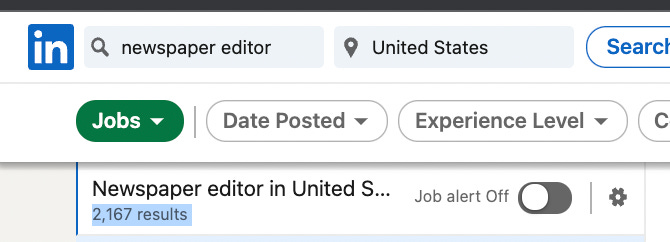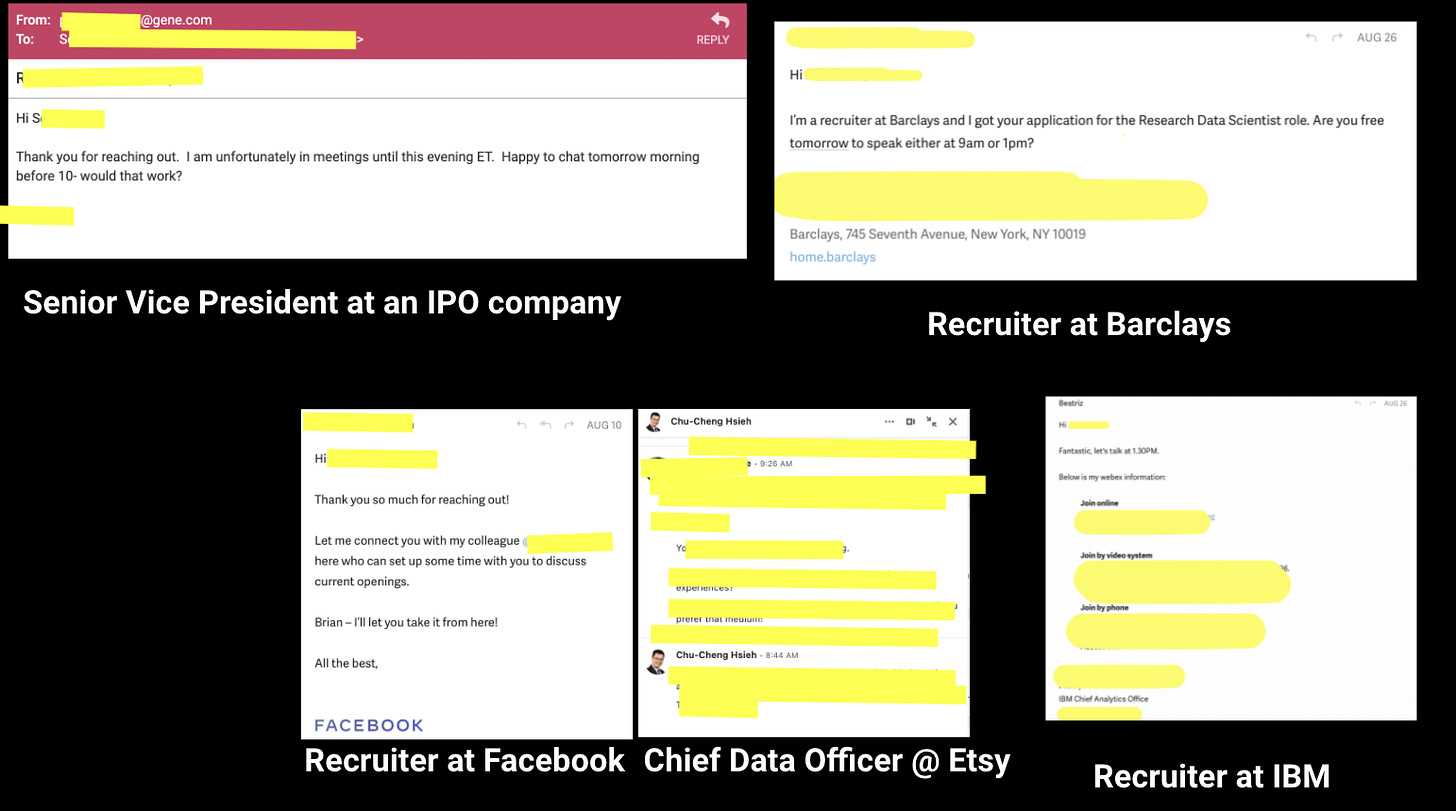30 interviews a month at companies like Microsoft, Goldman Sachs, and Stripe. Here's how.
Introduction
This 10 minute read will teach you a process you can use to get 30 interviews a month at places like Microsoft, Goldman Sachs, Stripe, and other billion dollar companies.
I did this for myself during the pandemic.
I then built Relentless, a done for you program, to get the same results for other job seekers without needing them to lift a finger.
Proof
Alice Farrell: "43 interviews at Stripe, Microsoft, Doordash, and other billion dollar companies, and a compensation increase of $65,000 in 4 weeks"
Marshall Conrad: "$30K compensation increase and 50 interviews in 4 weeks at companies like Carta and Affirm"
Ryan Lacey: "Got 30 interviews at companies like BCG and Fortune 500s"
Stage 1: Identify the role you’re perfect for
If you apply and get into Relentless, we’ll use software to answer this question.
If you’re doing this on your own, your best bet is to spend some time researching different roles and reflecting on your strengths.
The purpose of this stage is to find a role that meets the following criteria:
You’re interested in this role.
You’re good at this role.
Many employers are trying to hire for this role but can’t, because a relatively low number of candidates have the skills needed for the role.
A good proxy for this is the number of results that show up on LinkedIn when you look up the role.
For example, a product manager role has 20x the number of open job posts on LinkedIn than a newspaper editor role (43K+ and 2K+ job posts respectively).
43K+ job posts2K+ job posts
This role is the same across multiple companies.
For example, a B2B (Business 2 Business), SaaS (Software As A Service) Account Executive role is the same across most companies. It has an established set of responsibilities which are:Build account and lead lists, and outreach strategies for each account.
Reach out to accounts and lead lists via email, LinkedIn, and through other strategies to generate qualified sales meetings.
Meet with qualified customers, close them, and exceed sales quotas
Work with marketing, product, SDRs, and engineering.
Forecast sales activity and revenue achievement through sales tools.
Use sales operations tools like a CRM (Salesforce, pipedrive) to manage the pipeline.
Manage and optimize the full sales cycle from prospecting to closing viable leads.
On the other hand, a strategy manager doesn’t have an established set of responsibilities across most companies. At some companies the role requires you to manage marketing strategy and at others it’s an internal role.
Success for this stage is being able to articulate the 1 job that hits all 4 criteria above.
For example: "I'm going for product manager roles at series A startups in the healthcare industry in either New York City or San Francisco."
Note: Pick one role. It’s difficult to run an optimal search strategy if you target multiple roles. Plus, there is 1 role that fits you better than all others. The point of this first stage is to identify it.
Stage 2: Rebrand your resume and LinkedIn
A good resume and LinkedIn is one that perfectly pitches you for your target role.
This is why Stage 1 where you identify one role you want, is critical to having a good resume and LinkedIn.
If you apply to and get into Relentless, you’ll be advised on how to do this directly and get access to 100+ examples of past resumes as well as how well they’ve converted.
If you’re doing this on your own, here’s what I’d recommend:
Find 10 job posts in your role and identify 3-6 key themes that show up in every single post.
Then, write a resume where every bullet is directly related to 1 or more of the themes, and cut out everything that isn't.
For example, Ryan used the resume below to get 30 interviews in a single month at Fortune 500s, Boston Consulting Group, and an offer paying 20% more than he has ever been paid. You'll notice every single responsibility is related to the role they were targeting (social media marketing).
You'll also notice that he never actually held a social media marketing role, but he still tailored each bullet to be relevant to social media marketing.
Stage 3: Distribution
If you apply to and get into Relentless, this stage will be done for you.
If you’re doing this on your own, here’s what I’d recommend:
Step 1:
Use both Google Jobs and LinkedIn to find job posts, and look up jobs posted in the last week.
Here’s why:
LinkedIn is one of the most expensive job boards for companies to post on. A company that spends on hiring talent is likely to pay that talent more money, so you’ll end up with higher offers.
Google Jobs picks up on job posts from career pages of companies and other places on the internet that LinkedIn may skip. Seeing more roles gives you more opportunities to interview and land offers, so you’ll end up with more offers.
Querying for jobs posted in the last week allows you to apply to freshly posted jobs. More than 50% of active job posts have already been filled and you can decrease the time spent on these roles, by querying for jobs posted in the last week.
If you're international and applying to US based jobs, spend a few hours learning how to use myvisajobs and the e-verify database to identify jobs which may be more likely to sponsor you or consider you on OPT.
Step 2:
Identify 3 to 5 good leads (aka people to reach out to) at each company you're interested in.
Good leads are leads who score high on one or ideally both of the following:
Decision making power: Leads with high decision making power over whether a candidate gets hired include hiring managers of roles or recruiters tasked to the role. For example, executive recruiters recruit for Director / C-Suite positions, technical recruiters recruit for technical roles like Software Engineering and Data Science, senior recruiters recruit for senior / director level roles, and so on.
Probability of the lead replying: This is contingent on a few different factors. Leads who have a high probability of replying are the people who get the highest return on investment from interacting with you. I’ll explain this more later on in this article.
I ran experiments and found that who you reach out to matters literally 10x more than what you write.
Finding the hiring manager can result in a reply like this:
P.S. This candidate ended up getting to a final round interview with this company.
Step 3:
Source verified emails of each lead.
I've tested both email and LinkedIn as channels and found that email is much better for generating interviews.
The best way to get verified emails is use a tool like ZoomInfo or ContactOut, but they can cost up to $5,000 a year. I’ve bought them because I’m helping many people, but it probably doesn’t make sense for you.
The cheaper but more time consuming route is to use something like Name2Email.
The strategy you use just depends on whether your time or money is more scarce.
Step 4: Write killer copy that converts.
Here's the most important thing I've learnt about writing good copy: Maximize the return on investment you give people for interacting with you.
You can do this by affecting two levers.
Lever 1: Perceived value you're providing someone with
Lever 2: Amount you're costing them
Lever 1: The perceived value you're providing someone with
You can communicate your perceived value with 2 tools:
Pedigree, like a prestigious school or company.
Results, like a metric that demonstrates success in your target role.
Lever 2: The amount you're costing them
Money isn't the only resource you can cost someone. You can also cost them time and energy.
The shorter and clearer and email is, the less you're costing them in time and energy.
Here's the caliber of replies Relentless members get when we follow this process:
Step 5:
Do outreach and follow ups at scale. If you do this right and follow up well, your reply rates sky rocket. I’ve gotten high reply rates across all industries and role seniorities, because of the strategy and tooling I use to generate interviews. Here are some examples of my reply rates.
If interested in working with us, apply to Relentless here: https://joinrelentless.com/







